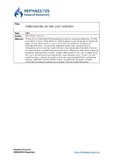| dc.contributor.author | Makridakis, Spyros | |
| dc.date.accessioned | 2015-12-08T09:43:34Z | |
| dc.date.available | 2015-12-08T09:43:34Z | |
| dc.date.issued | 1991 | |
| dc.identifier.uri | http://hdl.handle.net/11728/6373 | |
| dc.description.abstract | Those of us in the field of forecasting are facing a serious dilemma. On the one hand we know that
all forms of forecasting must be based on historical data, on the other hand we are well aware of a
plethora of empirical findings that show, beyond the slightest doubt, that minimizing the forecasting
errors during model Sitting is not necessarily the best criterion to improve post-sample forecasting accuracy. Moreover, the same empirical evidence indicates that simpler models often perform as well or better than the more complicated and statistically sophisticated ones. Finally. to add insult to injury, empirical evidence has also demonstrated that combining several methods (some of them clearly suboptimal) through a simple arithmetic average produces on average more accurate forecasts. | en_UK |
| dc.language.iso | en | en_UK |
| dc.publisher | International Journal of Forecasting | en_UK |
| dc.relation.ispartofseries | International Journal of Forecasting;7 | |
| dc.rights.uri | http://creativecommons.org/licenses/by-nc-nd/4.0/ | en_UK |
| dc.subject | Research Subject Categories::SOCIAL SCIENCES::Business and economics | en_UK |
| dc.title | Forecasting in the 21st century | en_UK |
| dc.type | Article | en_UK |


